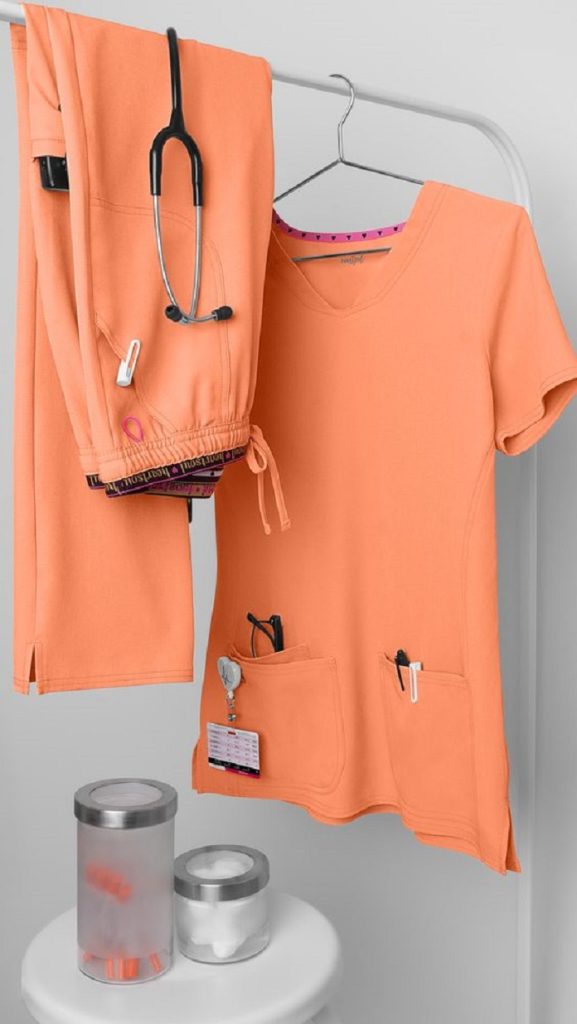
The full spectrum of colours we see in hospital hallways as the medical staff takes their rounds helping patients is quite a sight if you take a moment to think about it. Much like regular uniforms for businesses, scrubs reflect the personality and purpose of an organisation and can also be used to distinguish roles within a team.
The history of medical scrubs dates back to the early 1900s when they were first worn as a sign of hygiene and cleanliness in hospitals. This was a particularly vital practice during the 1918 flu pandemic when there was a desperate need for sterilisation and an alarming infection rate. Since then, these uniforms have become an integral part of hospital attire, allowing patients to identify the medical staff easily.
What Do Different Colours Mean?
Colour coding has become a norm in the medical field and helps distinguish roles within different departments. It essentially serves as a visual cue to identify the specific branch or specialisation of each staff member, as well as the role they play in patient care. Here are some widely recognised colour variations of these uniforms and their corresponding meanings:
Navy Blue

A true pillar of the medical world, this colour is a common sight in many hospitals all across the world. This particular shade is inherently very calming and soothing, with a deep, rich hue that symbolises trust, safety and professionalism. As such, both men’s and women’s navy scrubs are reassuring for patients and medical staff alike.
Speaking of evoking feelings of calmness, men’s and women’s navy scrubs are thought to have comforting properties for patients who suffer from high blood pressure or anxiety. The deep blue hue is believed to have a pacifying effect that helps reduce tension and instils feelings of security.
When patients enter the hospital, they’re often apprehensive, scared and maybe even a little confused. Navy blue uniforms give off an aura of authority and knowledge, which can go a long way in helping to put their minds at ease and build confidence in the medical staff.
Plus, men’s and women’s navy blue scrubs can be practical for surgeons as it helps contrast the darker shades of blood and the brighter colours of medical devices and instruments. Any spills or splashes will be easily noticed and addressed, effectively minimising the risk of cross-contamination or complication.
Not to mention, you can never go wrong with navy blue scrubs in terms of functionality and style. They’re classic, timeless and professional, with minimalistic designs that make for a sophisticated look. It doesn’t matter if you’re a doctor, nurse, surgeon or lab technician – these uniforms can be easily customised for any role.
Green

Next up is a shade we often see in emergency rooms, neonatal units and surgery departments, with a significance that goes far beyond its pleasing appearance. For one thing, the colour green is thought to represent growth, health and stability in many parts of the world.
In hospitals, it’s known for its comforting and therapeutic qualities. Green can create a placating and peaceful environment that helps both patients and medical staff feel safe, relaxed and secure. Its hue is associated with nature, healing and tranquillity, which can be a major benefit for those who are undergoing painful or uncomfortable procedures.
Additionally, it helps offset the bright red colour of blood because it neutralises its pigmented effects. In other words, it gives you more time to wear and use the scrub before it gets too stained and needs to be thrown in the wash.
Orange

Since red is a big no-no in the medical world as it reminds patients of blood and trauma, many hospitals opt to use orange instead. It’s a vibrant shade that stands out in any setting, so it helps improve visibility. As such, it’s often used in the ER and trauma units to help medical staff quickly and easily identify their colleagues.
Orange also has the unique ability to boost energy, stimulate creativity and evoke feelings of warmth. This can be beneficial for medical professionals who are feeling fatigued or overwhelmed, as the colour orange is thought to have a calming and energising effect.
Brown

The earthy shade of brown is often worn by nurses, doctors and lab technicians as it’s associated with reliability, trustworthiness and dependability. It exudes a sense of respectability, which can facilitate patient-doctor relations. It’s also known to generate feelings of comfort and security, which can be advantageous for those undergoing stressful medical procedures.
Moreover, it’s heavily associated with chocolate, which is thought to have a positive impact on mood. Many hospitals are now using brown scrubs to help bring some lightheartedness and humour into their medical environment.
White

The all-white uniform is a staple in the medical world and has been for centuries. This is likely due to its association with cleanliness, purity and sterility, as well as its ability to reflect light. It’s quite a practical choice as it can easily be bleached or washed to keep the fabric clean and hygienic.
The only downside is that some patients report experiencing headaches or eye strain due to the bright white uniform. Visual fatigue is likely caused by the reflective properties of white, so it’s best to combine this colour with another hue or pattern.















